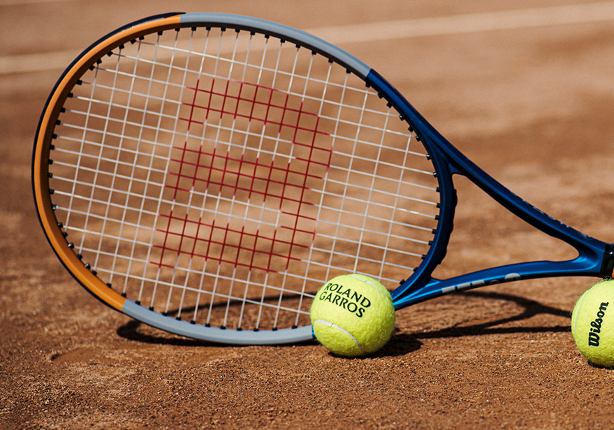
By Richard Pagliaro
Most of us won’t feel Roland Garros’ red clay beneath our feet this month.
Now, we can feel the French Open experience in our hands.
Thiem: Time For Haw-Eye At All Clay Events
Wilson has launched two new Roland Garros-inspired high-performance tennis racquets.
The exclusive Roland Garros (RG) Edition racquets include the Clash 100 RG and the Blade 98 (16x19 string pattern) v7.0 RG, which feature designs inspired by the venerable clay-court Grand Slam.
Both racquets present a modern aesthetic that reflects the red clay of Roland Garros. Accents of the famed French Open terre battue color at the tip of each frame are complemented by timeless slate gray and white at the three and nine o’clock positions for the Blade, and maritime navy and slate gray for the Clash.

It’s very cool looking cosmetic, but how does the Clash 100 RG actually play?
The Tennis Now staff got a chance to play-test the Clash 100 RG and we were impressed by the racquet’s comfort, feel and flex.
The Clash line, which was created over three years, is billed as the first racquet series explicitly created for the modern swing featuring racquet flexing without compromising stability or power.
Essentially, Wilson R&D designed the Clash aiming to create a modern racquet providing power with unprecedented feel thanks to the frame's flex.
It has absolutely succeeded in that mission in our view—this racquet feels and sounds different from any other major brand we’ve played with recently. A pop emanates from the sweet spot on contact. Listen for it in the video below of Roger Federer play-testing the Clash.
Of course “feel” is such an individual characteristic—what feels familiar to a player who grew up playing with wood racquets strung with gut, for instance, can often differ from the preferred feel of someone who’s played with lighter, modern sticks strung with polyester.
The sensation of the ball off the strings is the smoothest and least-stressful feeling we’ve had among any racquet we’ve play-tested in recent years. At the same time, you feel a vivid connection to the ball. For those reasons alone, the Clash 100 RG is well worth a play-test.
It’s more than the comfort level that appeals—this is a fun racquet to play with because it can help you offer answers from any position on the court. While it will appeal most to baseliners, if you’re an all-court player it transitions well to net, displays smooth maneuverability in the front court.
The Clash features two proprietary technologies: FreeFlex and StableSmart.
FreeFlex is a carbon mapping system that the brand claims "unifies carbon at unconventional angles throughout the racquets' frame for a higher degree of flexibility both vertically and horizontally."
Wilson says StableSmart is a new frame geometry designed to provide power and stability.
You can feel the flex operate when playing all court points hitting a series of groundstrokes and some slices and moving forward—it’s a racquet that rewards variety.
While we won’t expect to see former French Open champions Simona Halep and Jelena Ostapenko switch from their Wilson Blades to the Wilson Clash 100 RG, this racquet can work well for a wide range of recreational and competitive players from beginners all the way up through NTRP 4.5 level players.
That’s a primary reason the Clash is one of the world’s best-selling racquets: you don’t need to any major adjustments to reap its benefits.
Of course, perfection is an elusive quality in clay-court tennis and equipment. So what are the downsides?
Playing primarily with the Wilson Blade 98 16 x 19 racquet and the Dunlop CX 200 most recently, we noticed we broke more strings with the Clash 100 RG. We strung the Clash with both Tecnifibre RPX Natural Tennis String and Babolat RPM Blast strung at 52 pounds. By no means is the Clash a string eater, but we did break strings more often with it than with the other two frames, which are both 98-square inch heads.
So if you’re currently playing with a 98-square inch head racquet or lower, be aware of that or possibly play test the Clash 98, which comes in the traditional red, slate gray and black cosmetic. The Clash 98 is a bit heavier and features a slightly thinner beam width.
The Clash 100 RG is not as powerful as another best-seller, the Babolat Pure Drive, so if you tend to play grip-and-rip and prefer racquets with rocket-launcher power you won’t find raw unbridled power in the Clash. It's distinctive feel will likely provoke a strong reaction: either you'll be buzzing from the connection with the ball or know it's not quite right for your game within the first hitting session.
This racquet delivered comfort, control and plenty of depth. Overall, The Clash 100 RG has become our favorite racquet and so much fun to play and one we will continue to enjoy long after Roland Garros ends next weekend.
Photo credit: Wilson